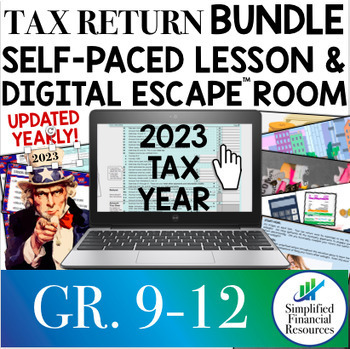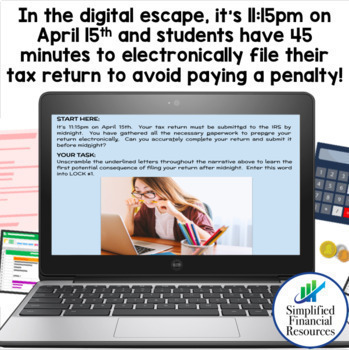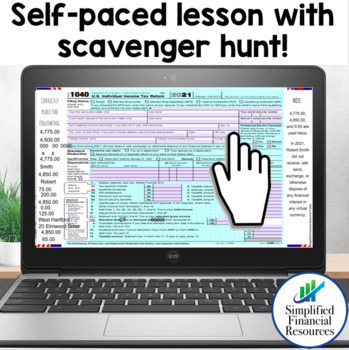Filing 1040 Tax Return Digital Escape Room Activity Year 2023 Bundle
- Google Slides™
- Internet Activities

What educators are saying
Products in this Bundle (2)
Description
Engage students in the process of filing a tax return with this 5-star rated bundle of tax return filing resources including an interactive digital escape room and a self-paced digital tax activity.
Both of these resources are updated yearly to reflect changes to taxation and are CURRENTLY UPDATED FOR THE 2023 TAX YEAR.
In the digital escape room, perfect as a culminating review activity (pre-quiz/test), supplemental activity, or extra credit assignment, students will review:
- Key terms of a tax return, including: filing status, deduction, dependent, social security number, refund, amount you owe, tax preparer designee, sign here, paid preparer, and tax return
- Tips or filing taxes, including: the need to review filing status each year, what to do if you receive an error on forms such as a W-2 or 1099, the need to still pay taxes by April 15th even if you gain an extension until October 15th, and more
- Where to enter common data on a tax return, including: total earned income; qualified dividends; Federal Income Tax Withheld from your W-2; applying a 2023 refund to 2024 taxes; and, a recent requirement, where to acknowledge if you bought or sold any virtual currency.
The digital escape room includes:
- Directions and rules
- A timer (set for 45 minutes)
- A “start here” narrative containing a word to unscramble
- Google Forms (which direct students to the key terms of a tax return task and tax tips maze)
- A jigsaw puzzle
- Hidden pictures (which direct them to comprehension questions and the final congratulatory note)
Technology requirements: *Please read before purchasing this resource*
Because this digital escape room is a Google Site, students will need a Google account to access the materials. Before purchasing this resource, please test:
- Google Sites: Please make sure your district DOES NOT BLOCK OUTSIDE GOOGLE SITES. I suggest checking with your IT department.
- Jigsawplanet.com: Students will not be able to access one of the activities without being able to access this site.
- Firewalls: I can't control firewalls that your school district may have in place and I'm not responsible if this site doesn't work at your school. Please be sure you check the sites above, and ensure your students have Google accounts so that this runs successfully.
In the self-paced digital learning activity, students assume the role of Robert Smith, a teen who just received a W-2 from his town's Parks and Recreation Center, where he worked in the summer of 2023. Robert's parents want him to have the experience of completing a tax return (filing as a dependent). Students will do that and more!
In this lesson, students will:
- define tax return, W-2, and 1040 and learn their history
- explain common errors in and learn common questions about filing returns
- complete a scavenger hunt, correctly transferring information on a W-2 to a 1040
- learn of their strengths and weaknesses in completing one
- reflect on their learning
Technology note: You need Google Drive to access and make use of these products.
See why this resource has been described as a "nice change of pace for my kids this morning. Yesterday, we went over tax forms, and completed a tax return. My senior economics students are routinely asking how 'to do' taxes"! ⭐️⭐️⭐️⭐️⭐️
Looking for other business education materials?
- Filing a Tax Return Digital Escape Room ⭐️⭐️⭐️⭐️⭐️
- How to Learn the Language of Business: A-Z Guide, Task Cards, Student Workbook
- The Economic Impact of Coronavirus/ COVID-19 on a Pizza Shop: Distance Learning ⭐️⭐️⭐️⭐️⭐️
- The Economic Impact of Coronavirus/ COVID-19 on a Technology Company Distance Learning
- The Economic Surge and Downtown of Businesses due to Coronavirus/ COVID-19 Distance Learning BUNDLE
- Virtual High School Business Classroom Google Slides Distance Learning Editable
Thank you for visiting my store! Please follow me (by easily clicking HERE!) to receive freebies and updates about new products!
Your feedback is valuable to me! I would love to hear your feedback on this resource. Simply go to your "My Purchases" page where you will see a review button. Click on "Have you used this resource? If so, leave a review." Each time you give feedback, TPT gives you feedback credits that you use to lower the cost of your future purchases. Thank you so much!
© Simplified Financial Resources





